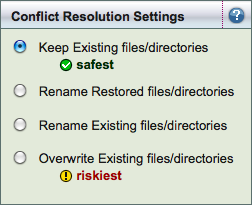Table of contents
ZMC Restore Where
The Restore Where page specifies the destination directory for recovered files. Before attempting a restore, you may want to review the Requirements for Restore Clients section of the pre-installation checklist.
The Restore Where defines where the data is to be restored. It also lets you control how the file restore operation proceeds. For example, you can choose whether to permit overwriting of existing files.
When you are restoring to Amanda Linux, Solaris or Mac OS X client, configuration is required on the client. See next section. For Windows client, no configuration is required other than client software must be installed on the machine being restored to.
Restoring to a Amanda Linux/Solaris/Mac OS X Client
- If you have not done so, install the Zmanda client software. The installation procedure is described in the Linux, Solaris and Mac OS X client manuals.
- Make sure that zmrecover is enabled on the client (enabled by default). Examine /etc/xinetd.d/zmrecover to make sure it includes the following line
- disable = no
Or, on Mac OSX systems, run the following command:
launchctl load -w /Library/LaunchDaemons org.amanda.zmrecover.plist.
For Linux/Solaris/Mac OS X clients, the /etc/amanda/amanda-client.conf file must be edited on the client (if the client and server do not reside on the same machine). Specifically, the following entries must be edited:
index_server "localhost" # your amindexd server tape_server "localhost" # your amidxtaped server
Change "localhost" to match to the hostname of the Amanda backup server.
Where would you like to restore to?

DLE/Object Type and Source Host Type are non-editable fields and they are provided for information to fill other fields.
- Destination Host Name
- The Destination Host is the machine where you want restore the files. It need not be the same machine that originally contained the backed up data.
- If no Destination Host is specified, the files are restored to the Amanda server machine.
- Destination Host Type
- Choose either Linux/Unix/Mac/Solaris or Windows.
-
- If the Destination Host is defined as Linux/UNIX the data will be restored as user root. You can specify a different user such as amandabackup to execute the restore. Please note restoring as a non-root user may not preserve directory/file ownership.
- If the Destination Host is running Windows, then the data will be restored as user amandabackup. This cannot be changed.
If you are restoring Windows backups to Linux/Unix/Mac/Solaris host, the data is restored as zip file which can be copied to Windows machine and extracted using pkzip or winzip tools that support ZIP64 format. Example message that appears in ZMC:
- When restoring Windows backup image files created by ZWC to non-Windows
systems, only the raw image file (ZIP formatted) can be restored. Please
make sure adequate space exists for restoring the entire backup image
file.
Linux/Unix/Mac/Solaris client backups cannot be restored to Windows.
- Destination Username
- Specifies the OS user on the destination machine that will provide access to the restore process. If the Destination Host has Amanda client installed, the user has to be root. For restoration of Windows backups, this field cannot be changed.
- If you are restoring to a machine that does not have Amanda client installed, restoration will be done using ssh. ssh must be configured on the Destination Host and the ssh user can be specified as Destination Username. ssh user password will be required at the start of restoration process. Only file system (not applications) data can be restored using ssh.
- Destination Directory
- The directory on the Destination Host where the files will be restored. It can be either Original location from where backup was performed or an alternate location (Destination Directory).
- Warning: The Destination Directory MUST be specified as an absolute path on the Destination Host.
- Temporary Directory
- A directory on the Destination Host that ZMC will use temporarily during the restore process. Please note that there should be sufficient space to store the whole backup image in this directory. The amandabackup user should have permissions to write to this directory.
Conflict Resolution
Conflict Resolution is displayed only for Windows, Linux, Solaris and Mac OS X file systems.

The radio buttons in the above panel lets you set how to handle filename conflicts in the destination directory (select one):
- Keep Existing Files
- If checked (the default), ZMC does not overwrite any existing files on the destination directory. Conflicting files are simply skipped.
- Overwrite Existing Files
- If checked, the entire pathnames of existing files on the destination will be overwritten by the backed-up versions, if any. Use with extreme caution.
- Rename Existing Files
- If checked, name conflicts are resolved by renaming the existing file (and the entire directory path to that file) using the following convention: original_filename.original.timestamp.
- Rename Restored Files
- If checked, name conflicts are resolved by renaming the existing file (and the entire directory path to that file) using the following convention: original_filename.original.timestamp.
Exclude

Express restores allows users to exclude file names or files/directories that match the exclude pattern. Multiple files or patterns (filename globbing syntax) can be specified.
